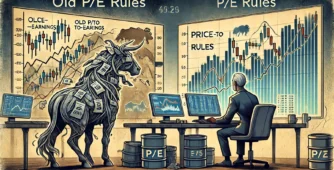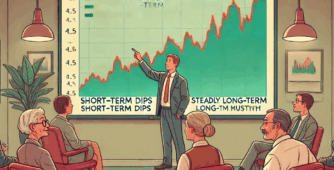We’re looking at an insightful chart shared by BarChart on X, which shows the asset allocation trend among US households. The equity allocation—represented by the dark blue line—is now at an all-time high. Debt (light blue) and cash allocations are hovering around 20% and 10%, respectively, with the rest possibly in housing, gold, or alternative instruments.

Historical Patterns of Equity Allocation
From the 1980s to 2000, there was a steady increase in equity allocation that peaked around the dot-com bubble. During this two-decade-long run, a whole generation of investors likely never saw a real equity bear market. It became a one-way trade—put money in the market and it just works. But post-2000, the dot-com crash brought a reality check, followed by a near-decade of flat returns. Equity allocations came off as both valuations dropped and investor sentiment changed.
The Post-GFC Rise and COVID Blip
After 2008, with central banks providing liquidity, the markets bounced back and equity allocations started rising again. Then came COVID-19, causing a short-term blip, but that too was met with massive stimulus and markets surged, bringing allocations back to record levels. Now, once again, equity allocation is around 50%, which is significantly high, especially considering that many households still have very low or no exposure to markets—meaning the actual allocation for invested households is even higher.
Why High Allocation May Be a Warning Sign
Historically, when equity allocations have reached these levels, they’ve often been followed by sharp corrections or a long period of flat performance. The early 2000s and 2022 dips are examples. In the past, such high allocations have also corresponded with broader economic challenges—high inflation, slowing growth, or even structural shifts in market leadership. The 1971–82 period is a good reference where equities underperformed and gold and real estate outperformed due to inflationary pressures.
Possible Shift in Asset Class Performance
If this cycle repeats, we might see gold or other real assets shine while equity allocations revert to the mean. Goldman Sachs’ interpretation of this data is not to forecast an imminent crash but to highlight the possibility that US markets might face a “lost decade” where returns are flat or subdued, especially in real terms.
Takeaway for Indian Investors
While this is US data, it gives an important insight for Indian investors too. Understanding long-term allocation cycles and being open to shifting between asset classes can help navigate future market scenarios better. In markets like India, where formalisation and economic growth are long-term tailwinds, there may still be opportunities, but global macro can’t be ignored.
WeekendInvesting launches – The Momentum Podcast
Join Yassar, a Dubai-based engineer turned investor, as he shares his 15-year journey—from Wall Street dreams to mastering systematic trading. In this debut episode, Yassar and Alok dive into real estate, gold, crypto, and key lessons for navigating markets.









